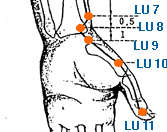LU 9
Acupuncture Point Theory
LU 9 Acupuncture Point Applications and Theory
 The acupuncture point "LU 9" , 太淵, is represented by "Tai Yuan" in pinyin and "Great Abyss" in english and may be found:
The acupuncture point "LU 9" , 太淵, is represented by "Tai Yuan" in pinyin and "Great Abyss" in english and may be found:
At the wrist crease on the radial side of the radial artery.
Of many possible clinical applications, it may be considered to influence the following issues/symptoms:
- Tonify LU Qi and Yin - cough, asthma, wheezing, SOB, chronic runny nose w/watery discharge.
- Palpitations.
- Wrist pain, arm pain along meridian.
- Hui Meeting Point of the Vessls - circulation issues, clarifying an indescernible pulse (for diagnosis).
- Main treatment point of Lung Sho pattern (with SP 3) - in Japanese style Five Phase treatment protocol.
LU 9 has some precautions to be considered (see our precautions list).
Avoid Artery (AA)
Lu 9 has the following theoretical associations which serve as important guideposts in designing an effective treatment protocol:
- Shu Stream Point
- Earth Point
- Yuan Source Point
- Hui Meeting Point of the Vessels
Explore lu 9 functional groupings theory - Hui Meeting, Shokanten - Nine Continent and/or YuanLuo, or read all point categories and related theory.
A single acupuncture point is not commonly thought of as an empirical way to influence a TCM diagnostic pattern. LU9, however, is a strong candidate to be incorporated into an acupuncture protocol for patients who exhibit: Lung Qi Deficiency and/or Lung Yin Deficiency
LU 9 may potentially be used, in coordination with a well designed acupuncture treatment protocol, to influence the following conditions: Asthma, Cough, Palpitations, Wheezing (Dyspnea) and/or Wrist Pain
While not necessarily valid clinically, HT 7 (Tonify deficiencies of the HT Qi, Blood, Yin and …), LI 5 (Local point for wrist pain. Classically noted wi…) and PC 7 (Cooling heat that is effecting the Heart of a def…) are nearby.
All Content 1999-2025
Chad J. Dupuis / Yin Yang House
Our Policies and Privacy Guidelines
Our Affiliated Clinics
